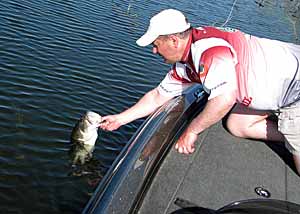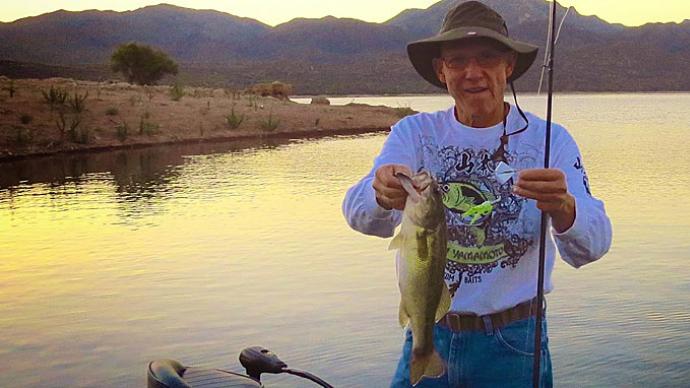
Summertime has always been my favorite time to fish. In fact, I am unashamedly a hot weather person. As several of my colleagues at work start talking with enthusiasm about ski trips in the winter my thoughts drift toward a desire to head to the equator.
My teenage years were spent learning how to fish in the heat of the day and in the summer months, after all the cooler weather seemed to necessitate the coming of hunting season. Even now, I find that the summer offers the most reproducible and reliable fishing if you use certain strategies.
Many folks consider summer a period for night fishing only. They certainly get away from the heat and, in some lakes, the ski and jet ski crowd. If you are going to get out on the lake in the mid-day and afternoon sunshine, you must take precautions. The problem with this next part of the sermon is that many of us ignore its content when we were young and are now paying the price. I recently tried to share some of these gems with a young friend of mine who guides on Lake Fork. I made a mistake by not realizing he was in his late 20's and thus in the "immortal, indestructible" stage of life. My suggestions for precautions were as well received as if I had beaten him with an AC plug.
In any case my intent in the following is not to cause alarm, but rather to offer proven guidance as to how an outdoor enthusiast should handle the summer. If you know a youngster who spends time outdoors, maybe he or she could look at the article even if fishing isn't their outside attraction.
The first major problem we have as humans is the vulnerability of our skin to sunlight. Our skin is a highly functional covering. It protects us against heat, light, injury, infections, and helps regulate body heat.
When we are born our skin provides us with virtually no protection from the sun. Exposure in infants can bring about serious and lasting damage. As we grow, the skin begins to provide a little more natural protection from sunlight. However, studies now indicate that up to 80% of skin damage has occurred by the time a person reaches 18 years of age. If you are light skinned, like me, the problem is even more complicated in that you are continually burning.
The major problem in sun damaged skin is a more rapid aging process and with the damage an increased risk of skin cancer.
Several factors increase the chance of getting skin cancer. Ultraviolet radiation (UV) from the sun is the main cause, but artificial sources of UV can also cause skin cancer. While anyone can get skin cancer the risk is greater for people with fair skin that freckles easily. It is often those who have red or blond hair, or those who have blue eyes that qualify (even though I think I remember I had black hair).
Skin cancer is more common where people get more UV radiation so we have many more cases here in Texas than occur in Minnesota where the sun is not as strong. Skin cancer is the most common type of cancer in the United States. It is projected that 40 to 50 percent of Americans who live to the age of 65 will have skin cancer at least once. The numbers go up appreciably in folks with outdoor jobs or hobbies.
Fortunately most skin cancers are slow growing and when caught in time can be removed surgically or treated with other methods successfully. The one skin cancer that can be life threatening is melanoma. Sun exposure is the main element to cause this type of cancer. However, due to a more aware population and earlier detection, the death rate is declining.
Self examinations, in which you find irregular areas of discoloration or redness on your skin are important. Any sore or irregularity of pattern in moles or freckles should also be a warning sign to you. If you notice any of these signs, see your doctor right away.
The first recommendation of any physician will be to combat summer exposure. That usually means simply staying out of the midday sun. Since that recommendation flies in the face of peak schooling activity, let's look at some other options.
The first is to dress for protection. This includes wearing a long-sleeved shirt and long pants, as well as a wide-brimmed hat. Okay, so we all favor our lucky bass fishing ball cap, but they just do not provide enough protection. If you also find the clothing to be too hot, a heavy dose of sunscreen on all exposed parts of your body will be necessary.
Sunscreen factors of protection change as the number it is rated increases. These products vary as to content and you must check for their intended use as well as the number factor. For example, some include a moisturizing component that keeps your skin from drying out as well. Most companies also offer a version that is water resistant and this doesn't slip off as you sweat. You many also note some are PABA free. This is a component in some sunscreens that can cause a reaction in certain individuals.
An increasing concern for outdoor lovers is the potential for changes in the atmosphere such as during ozone warnings. Any loss of inherent atmospheric filtration of sun rays makes us even more at risk. Folks who snow ski or go to higher elevations are even more vulnerable to the sun since there is less atmosphere to absorb the sun's rays.
You can't totally escape on overcast or hazy days since the damaging rays still get through. Most companies recommend sunscreen be put on several hours before fishing and then be reapplied during the day. It may be a nuisance, but cancer can and should be prevented.
As anglers we have even more compounded issues than golfers. Reflective surfaces, like water, can reflect more than half the sun's rays back on to the skin. Even sitting in the shade on the water does not guarantee protection from sunburn.
If you take any type of daily medication, be sure to check with your doctor as to whether or not the drug will carry a risk of photosensitivity. This side effect, with some prescription drugs and birth control pills, can cause even greater reaction to sunshine than you would normally get. If you have such a problem or your skin is easily burned, your doctor may recommend a sunblock. This type of protection, as the name implies, totally blocks out the sun's rays.
You may look like you belong to an aboriginal tribe once you put the sunblock on, but you won't redden. Some of these products should be put on with adequate time to dry since contact, while wet, can result in white spots on your seat and steering wheel.
There are certain parts of your body that are particularly vulnerable to sun exposure. These are the tops of your ears, cheeks, chin, and the back of your neck. Usually forget to put sunscreen back there, don't you?
While we're talking about skin exposure, what about your eyes? Among the things listed as suspect for creating cataracts, is exposure to UV light. Make sure that you protect your eyes from the sun by having tinted, polarized glasses with UV protection. Most of us are guilty of using polarized glass while fishing because we see in the water better, but may or may not use eye protection when driving on sunny days.
Another major problem in preparing for summer fishing is plenty of fluids. As you perspire, you actually dehydrate. Drinking fluids, particularly water, is critical. Many of the new ade-type drinks are excellent for putting back electrolytes. Overly sweet and carbonated drinks should not be taken as a substitute for water or one of the "ades."
Adults with a history of spending time outdoors should have an annual or regularly scheduled examination for pre-cancerous changes. Ask your doctor for one of the many free booklets on how to do a self examination, and then follow up by doing them.
Prevention is a heck of a lot better approach than treatment, so emphasize protection of your skin and eyes when outside and watch for the signs. All adults should instill in young anglers, little leaguers, golfers, or other outdoor oriented youngsters to create skin protection habits now to avoid paying for sun induced damage later in life.




